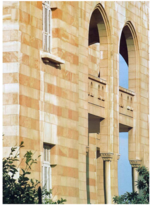Our Lady of the Annunciation Church, Amman
20th-century Roman Catholic church buildingsChurches in AmmanJordanian building and structure stubsMiddle Eastern church stubsRoman Catholic cathedral stubs ... and 2 more
Roman Catholic churches completed in 1962Roman Catholic churches in Jordan

Our Lady of the Annunciation Church or simply Church of Jabal Webdeh is a Catholic parish in Jabal al-Luweibdeh in the city of Amman.The parish is Roman (or Latin) rite, under the jurisdiction of the Latin Patriarchate of Jerusalem (Patriarcha Hierosolymitanus Latinorum). The parish celebrated its 50-year parish anniversary in 2012, and was restored for the occasion with funds from the Patriarchate. The Patriarchate was restored by Pope Pius IX in 1847 by the apostolic brief Nulla celebrior.
Excerpt from the Wikipedia article Our Lady of the Annunciation Church, Amman (License: CC BY-SA 3.0, Authors, Images).Our Lady of the Annunciation Church, Amman
Al-Akhtal Street, Amman منطقة المدينة
Geographical coordinates (GPS) Address Nearby Places Show on map
Geographical coordinates (GPS)
| Latitude | Longitude |
|---|---|
| N 31.95524 ° | E 35.92456 ° |
Address
Church of Our Lady of Annunciation
Al-Akhtal Street
11110 Amman, منطقة المدينة
Amman, Jordan
Open on Google Maps










